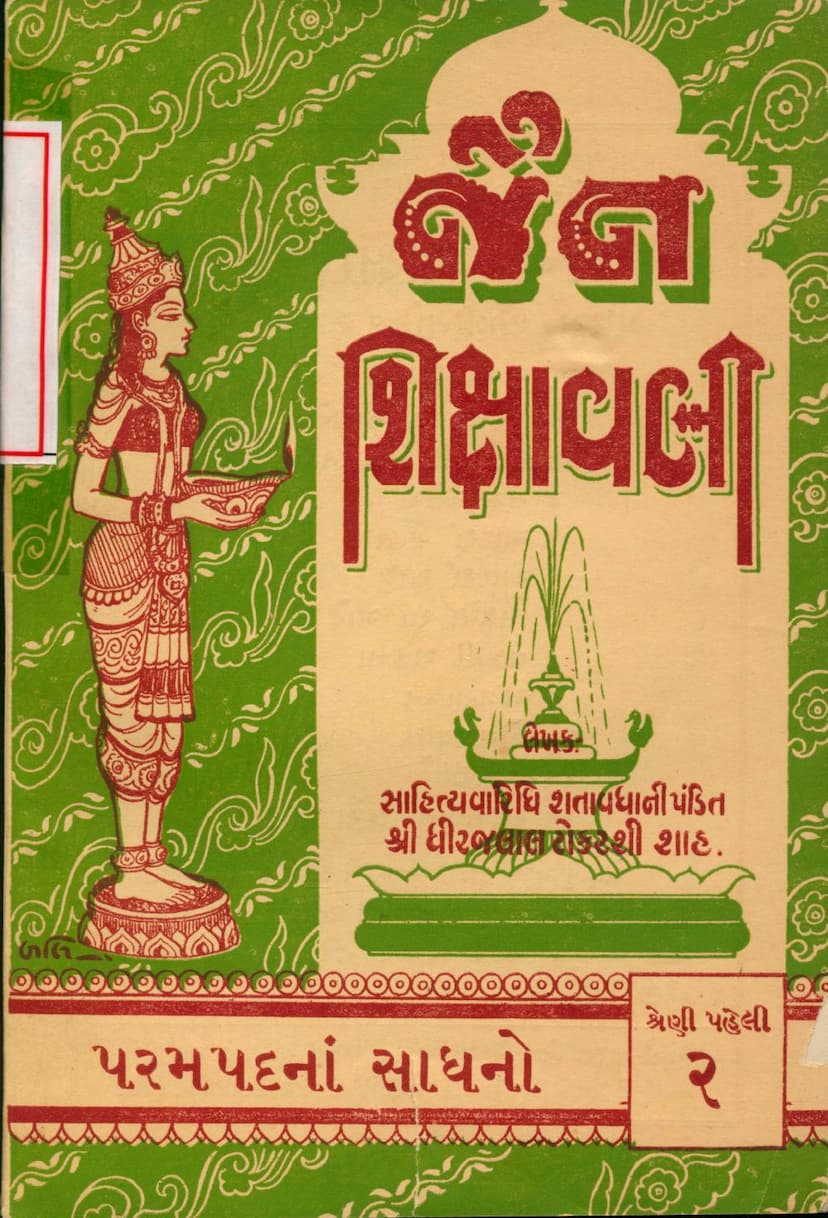Jain Shikshavali Parampadna Sadhano
Added to library: September 2, 2025

Summary
This Jain text, titled "Parampadna Sadhano" (Means to the Supreme State) by Dhirajlal Tokarshi Shah, is part of a larger series called "Jain Shikshavali" (Jain Education). This particular volume, the second in the first series, aims to present Jain philosophy and conduct in a simple and accessible style.
The book's primary focus is on the path to achieving Moksha or the Supreme State, explaining the fundamental principles and practices of Jainism. It begins by defining true knowledge as that which leads to liberation ("Sa Vidya Ya Vimuktye"). The author critiques modern education for its exclusion of spirituality, arguing that a life devoid of religion is akin to that of an animal.
A significant portion of the text is dedicated to explaining the Jain concept of Jnana-Vijnana (Knowledge and Science) through a dialogue between Lord Mahavir and his chief disciple, Gautam Swami. This dialogue illustrates a progressive understanding, starting from "Shravana" (hearing), leading to "Jnana" (knowledge of categories like soul, non-soul, karma, etc.), then to "Vijnana" (specialized knowledge of the self), and further to "Pratyakhyana" (renunciation), "Samyama" (restraint), "Aasrava" (non-influx of karma), "Tapa" (austerities), "Nirjara" (shedding of karma), "Akriya" (cessation of activity), and finally "Siddhi" (liberation). This hierarchical progression emphasizes that true knowledge leads to understanding the self, detachment from worldly pleasures, and ultimately, liberation.
The book then delves into the critique of "Atmaheen Adhunik Vigyan" (Modern Science Devoid of the Soul). It argues that while modern science has brought advancements, its materialistic approach, which often denies the existence of the soul, renders its achievements incomplete. The author presents the story of "Pradeshpratibandh" (The restraint of Pradeshi King) as a key narrative to illustrate the existence and nature of the soul. This detailed account describes how King Pradeshi, a staunch atheist who believed in the non-existence of the soul, was gradually convinced of its reality and the principles of Jainism through the insightful discourse of Acharya Keshi. The story highlights the importance of correct perception (Samyakdarshan) and the limitations of empirical reasoning when it comes to understanding the soul.
The text also addresses and refutes several "Bhul Bharellaa Mantavyo" (Mistaken Views) regarding the soul and its relationship with karma and liberation. These include:
- The view that the soul is momentary (Kshanik): The author refutes this by explaining the Jain concept of "Utpad, Vyay, Dhrauvya" (origination, decay, and permanence), stating that while the soul's modes change, its fundamental essence remains constant.
- The view that the soul is eternal but not the doer of karma: This is countered by explaining that the soul, though inherently pure, becomes bound by karma through attachment and aversion. The author also critiques the concept of an external God causing one's experiences.
- The view that the soul is not the doer but only the enjoyer of karma: This is illustrated through the satirical story of "Andheri Nagari ka Gandu Raja" (The Foolish King of the City of Darkness), showing the absurdity of blaming others for one's actions and the crucial role of individual agency.
- The view that the soul is eternal, the doer, and enjoyer, but cannot attain liberation: The author argues that through detachment and self-effort, the soul can indeed shed all karmas and achieve liberation, citing the example of Mahatma Dadhpra-hari.
- The view that liberation is possible but the means are not available: This is refuted by emphasizing the power of the soul and the effectiveness of Jain practices when pursued with sincere effort.
The book then elaborates on the "Saadhan Vichar" (Consideration of Means/Practices). It clarifies that while effort (Purusharth) is essential, it is facilitated by appropriate means (Sadhana). The author emphasizes the importance of choosing the right means for the right purpose, whether in practical or spiritual matters, using analogies of measuring cloth or grain.
It further discusses "Ek Saadhan" (One Means), highlighting Dharma (righteousness, duty) as the primary means, particularly characterized by Ahimsa (non-violence), Samyama (restraint), and Tapa (austerities).
The concept of "Do Saadhan" (Two Means) is explained as Jnana (knowledge) and Kriya (action). The author reconciles the debate between those who prioritize knowledge and those who prioritize action by presenting the "Andh-Pangu Nyay" (Blind and Lame Analogy), where cooperation between the blind (lacking knowledge) and the lame (lacking action) leads to salvation.
The core of the path is presented as "Teen Saadhan" or "Ratnatrayi" (Three Jewels): Samyakdarshan (Right Faith/Perception), Samyagjnana (Right Knowledge), and Samyakcharitra (Right Conduct). The importance of each is elaborated upon, stressing that Samyakdarshan is the foundation, leading to the other two. The text explains the progressive stages of attaining Samyakdarshan and its significance in overcoming Mithyatva (delusion).
Finally, the book touches upon "Anek Saadhan" (Many Means), acknowledging that different individuals may follow various paths prescribed by the Jinas, and adherence to even a single principle with complete sincerity can lead to liberation. The core message reiterates that the soul is eternal, the doer and enjoyer of its actions, and capable of achieving liberation through the prescribed means.
In essence, "Parampadna Sadhano" is a guide to spiritual progress within Jainism, emphasizing the supremacy of true knowledge, the existence of the soul, the importance of right conduct, and the ultimate goal of liberation, all presented in a clear and persuasive manner.